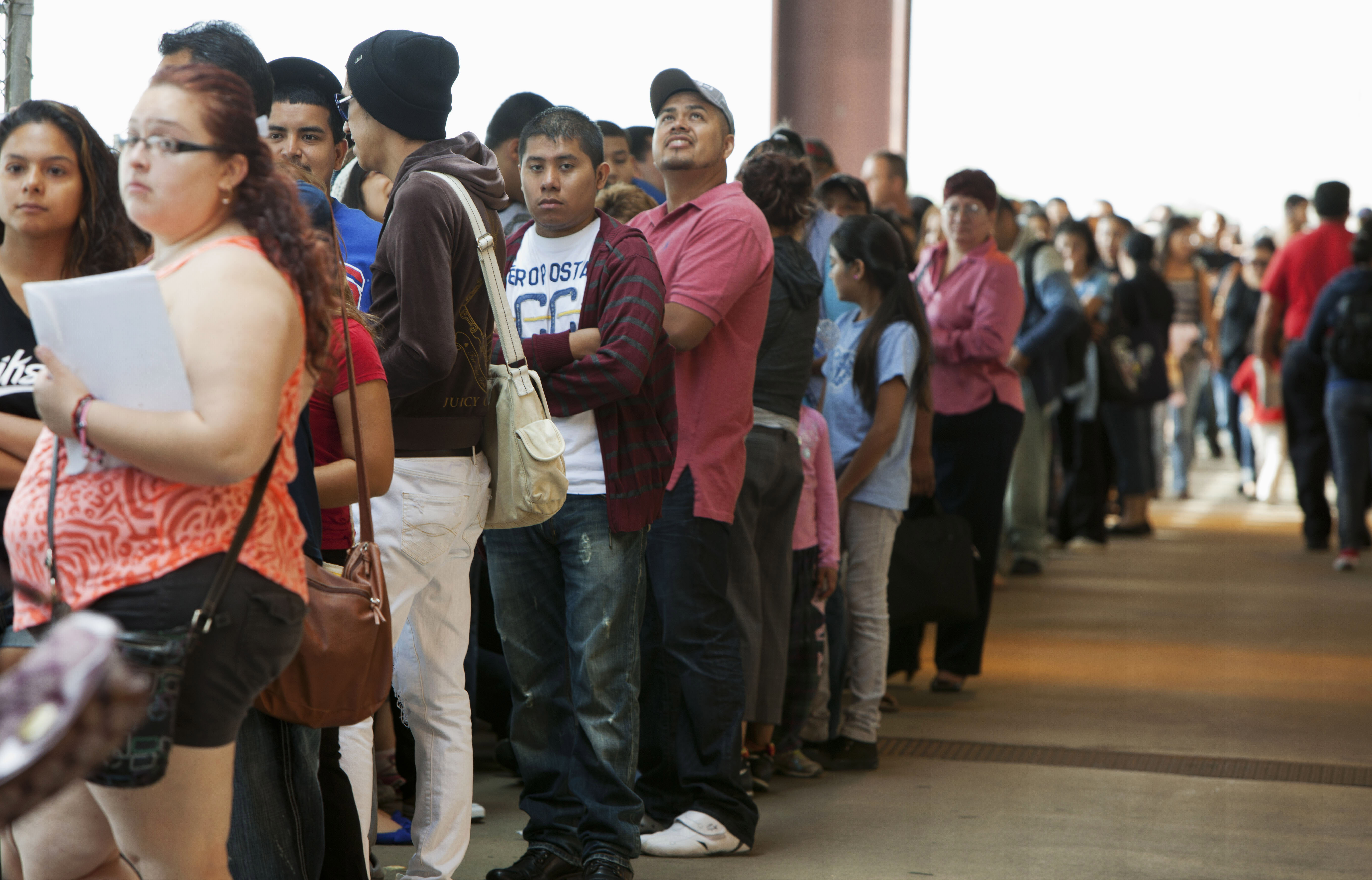Has the U.S. Really Shifted on Deportations?

Young immigrants stand in a long line at Chicago's Navy Pier on Wednesday, Aug. 15, 2012, for guidance with a new federal program that would help them work legally in the United States and avoid deportation. (AP Photo/Sitthixay Ditthavong)
After six years of taking a tougher stance on deportations, the Obama administration last year changed its policy on which undocumented immigrants it would target.
“Felons, not families,” the president said last November. “Criminals, not children. Gang members, not a mom who’s working hard to provide for her kids. We’ll prioritize, just like law enforcement does every day.”
The administration issued new guidelines on who should top the list for removal: threats to national security and people with felony convictions. Officials were directed to make others lower priorities, such as those with small children or who have served in the military, and victims of domestic violence or human trafficking, who can qualify for special visas.
But nearly a year later, officials at the Department of Homeland Security’s division of Immigration and Customs Enforcement (ICE) don’t always appear to follow those priorities, instead slating for removal people with longstanding ties to their communities, no criminal records, or those who potentially qualify for asylum or other forms of refuge in the U.S., according to interviews with immigration attorneys and preliminary federal data.
“They’re supposed to conduct a review around the substance of the case,” said Paromita Shah, associate director of the National Immigration Project. “And what we have found in our experience, and this is pretty consistent across the board, is that ICE continues to ignore all factors — except the detrimental ones.”
ICE said it makes removal decisions based on the facts it has at the time, but doesn’t have the capacity to fully investigate the details of each case.
“U.S. Immigration and Customs Enforcement (ICE) is focused on smart, effective immigration enforcement that prioritizes the removal of criminal aliens, recent border crossers and egregious immigration law violators, such as those who have been previously removed from the United States,” said Jennifer Elzea, an ICE spokeswoman.
While ICE hasn’t yet released data for 2015, a look at preliminary data suggests that the majority of the individuals that ICE asked local law enforcement to detain do not have criminal convictions.
Last November, the Obama administration officially ended Secure Communities, a program that allowed ICE to issue detainers, or requests to hold people in state and local custody that the agency believed were in the U.S. illegally, based on biometric data obtained during their arrests. Roughly 340 jurisdictions had refused to cooperate with the program, ICE said, which spurred the decision to shut it down.
The new Priority Enforcement Program, or PEP, introduced in November, still allows ICE to issue detainers based on biometric data, but only asks local law enforcement to notify federal officials when they are preparing to release someone who poses a threat. ICE said that has brought “over half” of those jurisdictions back on board, although it didn’t offer a specific number.
While there isn’t yet clear data on who ICE has asked to detain, an analysis by researchers at Syracuse University of 7,993 detainers issued in April 2015 showed that 67 percent of people had not been convicted of a crime. About 15 percent had been convicted of the most serious offenses. ICE provided only one month of data since the new memo took effect.
Complicating the picture is the greater numbers of people who have come to the U.S. from Central America, and may have credible asylum claims but remain at risk for deportation, attorneys and advocates say. Attorneys say they worry that women and children in family detention centers, as well as others swept up by ICE, may be deported before they have a chance to make a case, either for asylum or other relief.
“We have to go in and basically fight tooth and nail for each case,” said Mony Ruiz-Velasco, an immigration attorney in Chicago. “[We] spend an enormous amount of resources to stop deportations on cases that are not priorities. And so I just cannot imagine what is happening to all the people that are not represented.”
Nuvia is one case that Ruiz-Velasco has been fighting for. A 43-year-old mother of four, Nuvia came to the U.S. from Guatemala illegally for the first time in 1995. Nuvia asked that her last name not be published for safety and privacy reasons.
She stayed for more than a decade, marrying and having children, before she returned home to bury her father in 2011. When Nuvia returned to the U.S. in 2013, she said she was held captive in a home where she was forced to work and was sexually assaulted, according to an affidavit she provided to immigration officials.
After two weeks, Nuvia said she was able to escape, but was ultimately apprehended by immigration officials. She has since been slated for removal. She was allowed to return to her family while she waits for a verdict. Because of the court backlog, her case won’t go before an immigration judge until 2019.
Nuvia worries daily about being sent back to Guatemala. She stays at home, she says, and has fallen prey to depression. With help from Ruiz-Velasco, Nuvia has applied for a T visa, which is reserved for victims of human trafficking. She hopes to hear a verdict in the coming months.
“I don’t go out by myself for any reason,” Nuvia said. “It’s not a life, you know. It doesn’t go away.”
ICE wouldn’t comment directly on the case. Her attorney, Ruiz-Velasco, said Nuvia doesn’t fit the agency’s top categories for removal. “She’s not a priority for immigration in any sense of the word,” she said.





